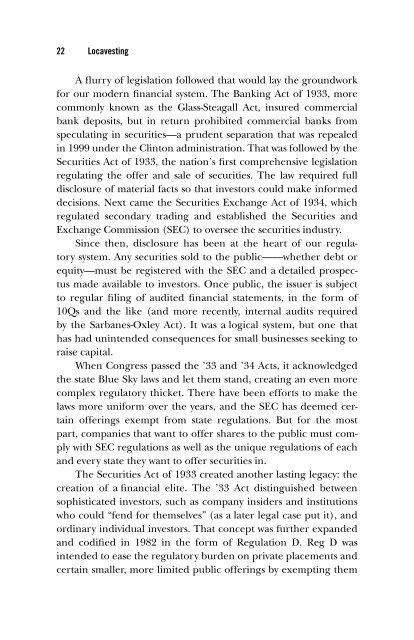3c hapter - Index of
3c hapter - Index of
3c hapter - Index of
Create successful ePaper yourself
Turn your PDF publications into a flip-book with our unique Google optimized e-Paper software.
22 Locavesting<br />
A fl urry <strong>of</strong> legislation followed that would lay the groundwork<br />
for our modern fi nancial system. The Banking Act <strong>of</strong> 1933, more<br />
commonly known as the Glass- Steagall Act, insured commercial<br />
bank deposits, but in return prohibited commercial banks from<br />
speculating in securities—a prudent separation that was repealed<br />
in 1999 under the Clinton administration. That was followed by the<br />
Securities Act <strong>of</strong> 1933, the nation’s fi rst comprehensive legislation<br />
regulating the <strong>of</strong>fer and sale <strong>of</strong> securities. The law required full<br />
disclosure <strong>of</strong> material facts so that investors could make informed<br />
decisions. Next came the Securities Exchange Act <strong>of</strong> 1934, which<br />
regulated secondary trading and established the Securities and<br />
Exchange Commission (SEC) to oversee the securities industry.<br />
Since then, disclosure has been at the heart <strong>of</strong> our regulatory<br />
system. Any securities sold to the public——whether debt or<br />
equity—must be registered with the SEC and a detailed prospectus<br />
made available to investors. Once public, the issuer is subject<br />
to regular fi ling <strong>of</strong> audited fi nancial statements, in the form <strong>of</strong><br />
10Qs and the like (and more recently, internal audits required<br />
by the Sarbanes- Oxley Act). It was a logical system, but one that<br />
has had unintended consequences for small businesses seeking to<br />
raise capital.<br />
When Congress passed the ’33 and ’34 Acts, it acknowledged<br />
the state Blue Sky laws and let them stand, creating an even more<br />
complex regulatory thicket. There have been efforts to make the<br />
laws more uniform over the years, and the SEC has deemed certain<br />
<strong>of</strong>ferings exempt from state regulations. But for the most<br />
part, companies that want to <strong>of</strong>fer shares to the public must comply<br />
with SEC regulations as well as the unique regulations <strong>of</strong> each<br />
and every state they want to <strong>of</strong>fer securities in.<br />
The Securities Act <strong>of</strong> 1933 created another lasting legacy: the<br />
creation <strong>of</strong> a fi nancial elite. The ’33 Act distinguished between<br />
sophisticated investors, such as company insiders and institutions<br />
who could “fend for themselves” (as a later legal case put it), and<br />
ordinary individual investors. That concept was further expanded<br />
and codifi ed in 1982 in the form <strong>of</strong> Regulation D. Reg D was<br />
intended to ease the regulatory burden on private placements and<br />
certain smaller, more limited public <strong>of</strong>ferings by exempting them
















